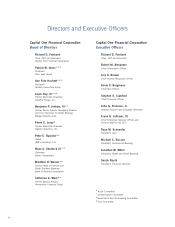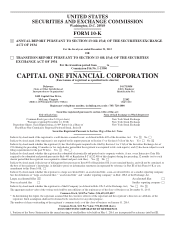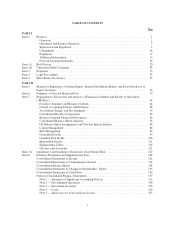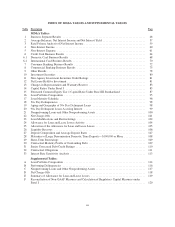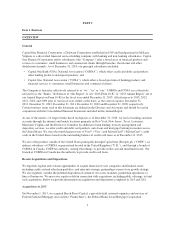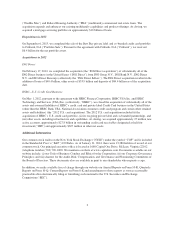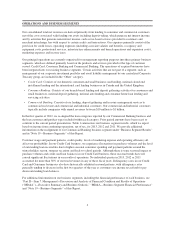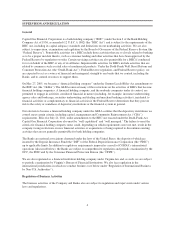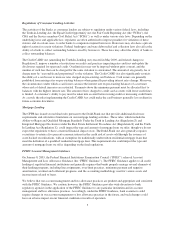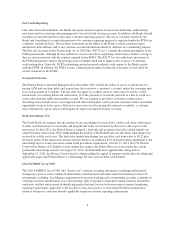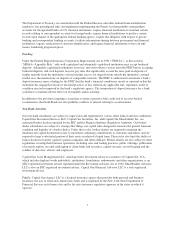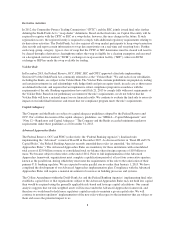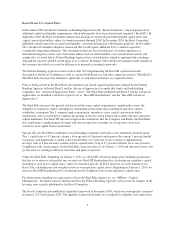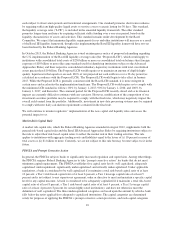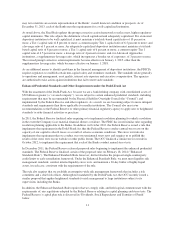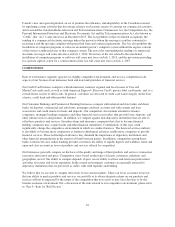Capital One 2013 Annual Report Download - page 26
Download and view the complete annual report
Please find page 26 of the 2013 Capital One annual report below. You can navigate through the pages in the report by either clicking on the pages listed below, or by using the keyword search tool below to find specific information within the annual report.Fair Credit Reporting
Like other financial institutions, the Banks rely upon consumer reports for prescreen marketing, underwriting
new loans and for reviewing and managing risks associated with existing accounts. In addition, the Banks furnish
customer account information to the major consumer reporting agencies. The use of consumer reports by the
Banks and furnishing of account information to the consumer reporting agencies is regulated under the FCRA on
a uniform, nationwide basis. This includes restrictions on the ability of the Banks to share consumer report
information with affiliates and to use customer account information shared by affiliates for a marketing purpose.
The Fair and Accurate Credit Transactions Act of 2003 (the “FACT Act”), extends the federal preemption of the
FCRA permanently, although the law authorizes states to enact laws regulating certain subject matters so long as
they are not inconsistent with the conduct required by the FCRA. The FACT Act also added new provisions to
the FCRA designed to address the growing crime of identity theft and to improve the accuracy of consumer
credit information. Generally, FCRA rulemaking and enforcement authority with respect to the Banks resides
with the CFPB. In addition, the FCRA creates a limited private right of action for consumers to seek relief for
certain violations of the FCRA.
Overdraft Protection
The Federal Reserve amended Regulation E in November 2009 to limit the ability to assess overdraft fees for
paying ATM and one-time debit card transactions that overdraw a consumer’s account, unless the consumer opts
in to such payment of overdrafts. The rule does not apply to overdraft services with respect to checks, ACH
transactions, or recurring debit card transactions, or to the payment of overdrafts pursuant to a line of credit or a
service that transfers funds from another account. We are required to provide to customers written notice
describing our overdraft service, fees imposed and other information, and to provide customers with a reasonable
opportunity to opt in to the service. Before we may assess fees for paying discretionary overdrafts, a customer
must affirmatively opt in, which could negatively impact our deposit business revenue.
Debit Interchange Fees
The Dodd-Frank Act requires that the amount of any interchange fee received by a debit card issuer with respect
to debit card transactions be reasonable and proportional to the cost incurred by the issuer with respect to the
transaction. In June 2011, the Federal Reserve adopted a final rule and an interim final rule (which largely was
adopted in final form in July 2012) implementing the portion of the Dodd-Frank Act that limits interchange fees
received by a debit card issuer. The final rules limited interchange fees per debit card transaction to $0.21 plus
five basis points of the transaction amount and provided for an additional $.01 fraud prevention adjustment to the
interchange fee for issuers that meet certain fraud prevention requirements. On July 31, 2013, the U.S. District
Court for the District of Columbia issued a ruling that requires the Federal Reserve to reconsider the current
permissible interchange amount. On August 21, 2013, the Federal Reserve appealed this ruling and on
September 19, 2013, the District Court stayed its ruling pending the appeal. It remains unclear how the ruling and
appeal will impact the Federal Reserve’s interchange fee rules and our debit card business.
USA PATRIOT Act of 2001
The USA PATRIOT Act of 2001 (the “Patriot Act”) contains sweeping anti-money laundering and financial
transparency laws as well as enhanced information collection tools and enforcement mechanisms for the U.S.
government, including: due diligence requirements for private banking and correspondent accounts; standards for
verifying customer identification at account opening; rules to promote cooperation among financial institutions,
regulators, and law enforcement in identifying parties that may be involved in terrorism or money laundering;
reporting requirements applicable to the receipt of coins and currency of more than $10,000 in nonfinancial
trades or businesses; and more broadly applicable suspicious activity reporting requirements.
6


